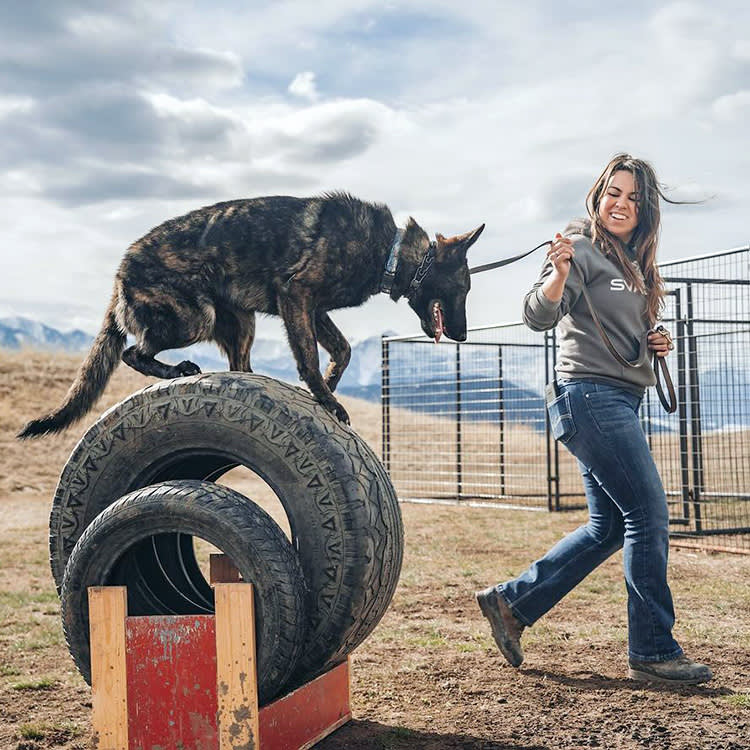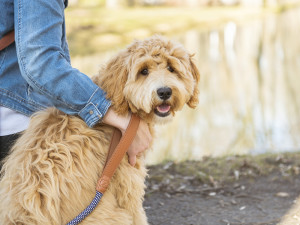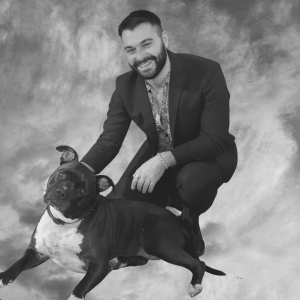No One Needs a $150,000 Svalinn Luxury-Bodyguard Dog
There are plenty of trainable dogs at shelters.
Rich people do a lot of silly things with their money; it comes with the territory. They have to use it on something. They obviously can’t donate it or pay their fair share of taxes — that’d be absurd. So, instead, they collect flashy cars, produce terrible roots rock music, and buy the New York Knicks before holding them hostage from relevance for 30 years. And that’s just James Dolanopens in new tab.
The latest costly status symbol might inspire more than eye rolls from people like us mourning the greater societal opportunity costs. As New York Magazine reported last weekopens in new tab, they’re known as “Svalinn dogsopens in new tab,” a fairly recently developed “breed” that apparently offers military-grade protection. (The word “svalinn” comes from Nordic mythology about a legendary shield that protects the world from the heat of the sun.)
Trick question: All dogs are perfect! But find out which type is the best fit for you.
Oh, and these dogs start at $150,000. There are a lot of things that are wrong about this company and their philosophy. How did it even come about? Why is there a demand for these dogs? And what do their lives look like before they are purchased for six figures?
What are Svalinn dogs, and who’s buying them?
Given the one percent’s obsession with exclusivity, it’s unsurprising that Svalinns are only available from a singular source. The pseudo-new breed’s distinction is a combination of their unique genetic makeup and early upbringing. Svalinns are born through crossbreeding of German Shepherds, Dutch Shepherds, and Belgian Malinois with the aim of having a loyal pet. In fact, the company advertises its pups with the slogan “Bred to love. Trained to protect,” which admittedly sounds like a scrapped Paul Blart: Mall Cop tagline.
How much do you spend on your pet per year?
According to the company’s website, Svalinns begin their training at eight weeks, and it continues for two to three years before they’re put up for sale. Svalinn claims that it only sells about 20 dogs every year and that roughly 350 currently exist in total. The company states that potential buyers go through a significant vetting process before welcoming a Svalinn dog into their lives. Although, the pool of people who can afford that price tag is clearly small, so it’s hard to imagine many miss the cut.
Svalinn has been breeding and training these dogs since 2005, when the company was first founded in Nairobi. The company is led by CEO and founder, Kim Greene, whose business card reportedly reads “Alpha Female,” referencing the archaic and disproven dog dominance theory.
As New York reports, in 2013, Greene and her then-husband (Greene now runs the company on her own) moved their operations to a former equestrian-training facility outside of Livingston, Montana. New York says the Greenes made this move “intent on creating a market for beasts that could rip out an attacker’s trachea yet also function as pets” and also reports that Svalinn is in “one of the remotest parts of the country,” where many of her clients live.
And we’re talking rich clients — the kinds of people with a net worth that might make them paranoid about having harm done to them at any given moment, hence the apparent need for protection. In the piece, Greene describes her clients as “high-level people, economically and socially.” To give you an example: Svalinn dogs are particularly popular at the Yellowstone Clubopens in new tab in Big Sky, Montana, where Mark Zuckerberg and Bill Gatesopens in new tab are among the vacationers. So, naturally, these are the types of people who have very specific demands about the kinds of dogs they want.
“People say, ‘I have a big motorboat. I need to have my dog climb out of the water on a ladder,’” Greene told New York. So, it’s no shock that Greene, someone who is breeding animals to fit the needs of people who worry about whether their dog can access their boat, refers to them as “assets.”
All of the services offered to Svalinn clients (for example, a handler visits you and the dog 45 days later to check in on their training) seem great, but, uh, the larger point is that it doesn’t sound like we’re talking about a living, breathing being — but rather a product. These people are paying $150,000 for a dog who, the article concedes, are basically being thought of as “luxury objects, like an out-of-tune Steinway,” as the New York reporter observes.
These dogs are raised in harsh conditions on purpose.
Let’s address the training philosophy at Svalinn. New York reports that Greene is a member of the “aversive” training camp, which means exposing them to the elements of nature, as would happen if they were wild dogs. They are trained in the on-campus facility called the Phoenix. The article describes it as an obstacle course “resembling a jungle gym” complete with “swinging tires the dogs have to leap through, balance beams narrower than their paws.” The coarse changes every day so the dogs have to really work their brains to get through it, resulting in a dog who isn’t fearful of any new challenge.
And while that might just sound similar to what any elite athlete goes through day in and day out, let’s remember: These are dogs whose lives are regimented in a way that doesn’t seem to include much fun. Greene says she wants one of her dogs to be one who “comes through the door with its shoulders thrust forward,” as opposed to the “adoring family oaf” who doesn’t need to “do anything other than wag their tail and be goofy and cute.”
This is clearly not a warm and fuzzy place, nor is it meant to be. The dogs live in what’s called “the Pit,” which the reporter describes as “a dirt-floored barn with an odor so intense I feel the urge to run outside.” Greene said she likes to “keep everything as close to nature as possible.” As the article reports, this means “choke collars, no toys or treats, and a diet of beef or raw elk meat served on the bone.”
Greene is quoted saying, “If nature takes puppies, it takes puppies.” In other words, per New York Magazine, if the puppies are abandoned by their mother and are at risk of dying, no one on staff intervenes. “If we were a puppy mill, we would sleep with the puppies ... We’d give them heat lamps. But you know what? These are protection assets. And if six of them are going to pass, there’s a reason.”
In response to that remark, a New York Magazine commenter wrote: “Really? I’ve worked in animal welfare for 25-plus years, and no puppy mill I’ve ever been in had heat lamps. Nor would I want to sleep in one. They are torture chambers.” So, yeah. That point is not exactly working in Greene’s favor.
Bottom line: Don’t get a dog as a status symbol.
Beyond the (very) problematic philosophy at Svalinn is the fact that these dogs aren’t even necessarily a good fit for the people who want them. We spoke with Leigh Siegfried, the founder and training director of Opportunity Barksopens in new tab, who says that the three breeds that make up a Svalinn dog — German Shepherd, Dutch Shepherd, and Belgian Malinois — all have high prey drives.
A real possible problem with that prey drive is that these dogs probably wouldn’t make the best pets for children. If some millionaire couple is looking to give their kid a cuddly pet while also showing off their status-establishing Svalinn, they might want to reconsider. “I would imagine that those dogs may not be amazing family dogs because they’re skewing for breeding that’s looking for a particular, probably off-the-charts, drive. They want sound temperaments but that may not be the target for that type of breeding,” Siegfried explains.
It’s important to note that with this degree of militant training, these animals will likely struggle to fully turn that type of thinking off. “I get it; it’s a family pet. But if it’s been living in an environment where it’s been trained for two to three years in a row; it’s a working dog. It’s a dog that’s nice to people that it knows and that also has the ability to turn on and do protection-based tasks,” Siegfried adds.
It’s also fair to ask what exactly these people are so afraid of that they need protection from. Not to mention, if you’re an overly anxious or fearful person in general, it’s not out of the realm of possibility this dog would be cued to protect you from something or someone who is being misinterpreted as a threat. “Does the dog have a level of discernment to autonomously make those calls?” Siegfried wonders.
Does anyone need a dog like this? No.
To be clear, adopting over shopping is the way to go, especially right now, as shelters across the U.S. are severely overcrowded and understaffed. There are simply far too many pups without homes suffering in overpacked shelters across the country that face the daily threat of euthanasia. Breeders not only steer potential pet parents away from shelters and rescues, but the worst versions are one of the reasons they’re so full in the first place.
We’re not even saying that these mega-rich folks should adopt a dog and donate the other $149,750 to shelters in need — though, they may consider it simply because it would do wonders for the ol’ public image. There are simply more affordable, better ways of introducing a great dog into your life, especially if you value who they are more than where they came from. And we believe the vast majority of pet parents do. As Siegfried says, “Most people are aiming for, like, friendly with the side of ‘someone knocked on my door and my dog goes bananas.’”
Dogs are pets; they’re not break-in-case-of-emergency handguns or furry pepper spray. If you have this kind of money lying around, and you want protection, maybe consider hiring a bodyguard. And $150,000 is a great starting salary.










